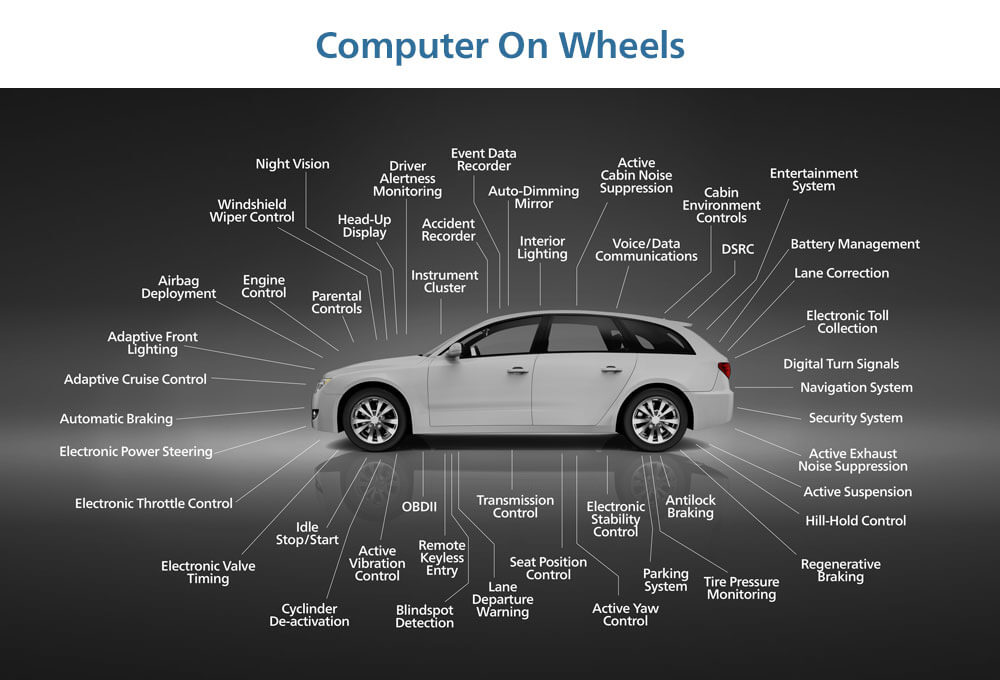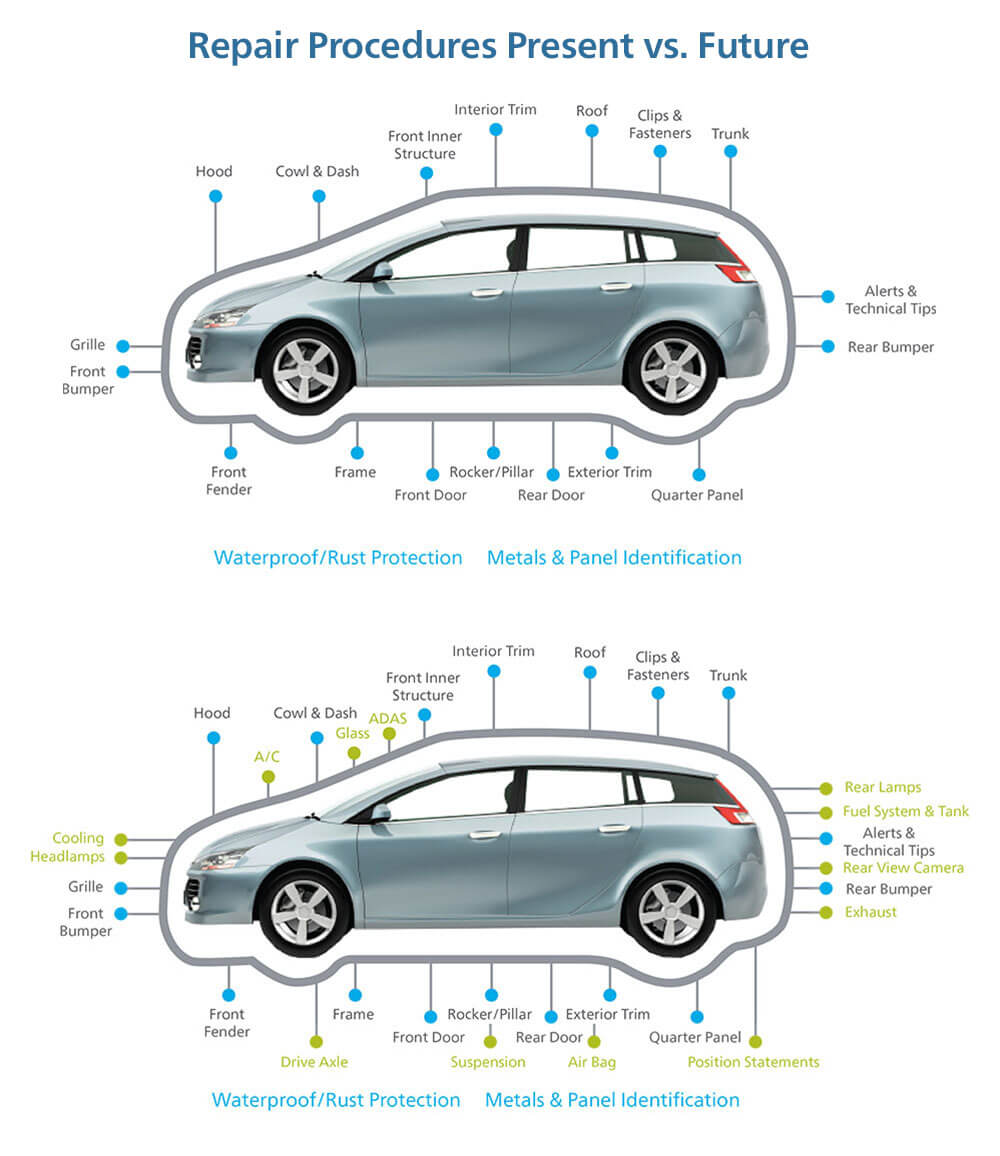Collision Repair Will Never Be the Same
The repair network of today is not your grandfather’s or your father’s repair network; in fact it may not even be your older brother’s repair network. Vehicles are becoming more sophisticated with every new model that rolls off the production line. They’re no longer merely a mode of transportation—they’re complex computer networks on wheels. Bob Lutz, from General Motors acknowledged this trend: “there’s not a single product we use today that isn’t becoming sophisticated from an electronic perspective or a technology perspective.” Did you know that the average new car comes with more than 100 million lines of code? That’s ten times more than a Boeing 787 Dreamliner and twice as many as the Large Hadron Collider.1 It should come as no surprise to anyone these days that with this advanced sophistication comes unprecedented complexity in repairs.
There’s not a single product we use today that isn’t becoming sophisticated from an electronic perspective or a technology perspective.
Material Composition Complexity
Vehicle complexity is not just related to electronics. Driven by CAFE standards combined with consumer preference for IIHS and NHTSA safety ratings, material composition complexity has exploded as well, based on the use of advanced materials. Comprising 13 different materials, including high-strength aluminum and high-strength steels,2 the Cadillac CT6 is just one example of a manufacturer’s embracing mixed materials to improve performance and efficiency. Repair shops require multiple welders, specialized repair bays, rivet guns and the latest adhesive systems to repair modern vehicles. All of these advanced joining or bonding methods require specialized training to go along with them. Also, today’s vehicles require diagnostics tools that have the latest OEM-level capabilities. Advanced Driver Assistance Systems (ADAS) recalibrations increasingly involve OEM vehicle-specific target or mirror systems based on many common collision repair procedures, including some of which you might not even be aware.3
In 1965 a technician needed to understand 5,000 pages of service manuals to fix any automobile on the road. Today, that same technician must be able to decipher over 500,000 pages of technical text.
The first 92 years of automotive innovation, from 1908 through 2000 brought us flashing turn signals, cruise control, airbags, crumple zones and anti-lock brakes. Vehicle technology has advanced exponentially since then We’ve gone from back up cameras to experimental autonomous cars in less than a decade. According to the U.S. Secretary of Labor, “In 1965 a technician needed to understand 5,000 pages of service manuals to fix any automobile on the road. Today, that same technician must be able to decipher over 500,000 pages of technical text.” Isn’t it time for repair networks to evolve alongside the most sophisticated machines on the planet?
The Right Information at the Right Time
From part details to VINs and labor times to service information, the types of data required for proper and safe repair vary as much as the amount of data does. Partial or incomplete data from OEMs and third parties create inefficiencies and delays in vehicle repair processing. To address these challenges, Mitchell’s solutions offer the right information at the right time through direct access to the latest electronic OEM data and real-time access to APIs as well as data from our key partners.
What Do Proper and Safe Repairs Require?
To answer this question, first we must examine the significance of OEM procedures and their role in the estimating and repair planning process. While there has been a significant amount of discussion on the importance of OEM procedures as they relate to parts and repairs, there has not yet been adequate discussion of the estimating and repair planning process. What should be examined is the importance of OEM information in the estimating and repair planning process because proper repair plans drive proper and safe repairs. This is not just about fixing the damaged sheet metal, facias, and lamp assemblies correctly. It’s not enough to have skilled, knowledgeable technicians using visual damage assessment skills find gaps and hidden damage. The bar is being raised for the entire collision repair industry to focus first on accurate identification of all the necessary steps to repair both the structural components of a vehicle and to restore its electronic systems and software to original condition. In your grandfather’s day, damage was a predictor of specific necessary repairs. Today, OEM repair information is required to plan the repair. It’s worth repeating that from parts to operations to post-repair calibrations, proper repair plans drive safe and proper repairs.
Mitchell’s Role in the “New” Repair Network
Since 2000, we have created Repair Standards (aka Repair Procedures) in Mitchell TechAdvisor for all core collision related categories for cars, trucks and vans. Our procedures include 25 core categories and 15 special categories for 900 models from 45 different OEMs. Based on the changing market we are augmenting our content to include even more information for collision repairers, including adding 72 new categories.
In addition, the “meticulous disassembly” or teardown process of the future is here today with Mitchell Diagnostics, the first comprehensive diagnostic workflow solution that is designed specifically for collision repair and auto claims. For example, there’s no comparison between Mitchell Diagnostics and a stand-alone scan tool and a connected diagnostic system. Our system’s approach interacts with other data streams during tear-down. It integrates scan reports into the repairers existing workflow. Carriers prefer the documentation provided by Mitchell Diagnostics over the flat file output of a scan tool because our documentation proves the necessary diagnostic procedures were completed correctly. Shops prefer Mitchell Diagnostics because it’s part of their overall repair and claims management infrastructure, delivering OEM level capabilities in a cost effective solution that works for making proper and safe repairs to nearly all makes & models.
A Dynamic Approach to Repair Networks
Just as generic repair methods and techniques are no longer adequate, neither is a static repair network. Continuous monitoring and adjustment of a dynamic network is required. Facilities must continually adjust their capabilities with new equipment, and new vehicles require new training and certifications for technicians. While all networks strive to deliver proper and safe repairs, one size does not fit all. Repairers are likely to participate in both OEM certified and carrier DRP programs. Since the KPIs and metrics for each program may differ, it is critical to have in place a system that allows for the management of proper and safe repairs, especially against varying criteria. We learned from recent litigation that the adherence to OEM repair procedures is more important than ever for making proper and safe repairs. While repair networks need to be both flexible and thoroughly up to date as vehicles become ever more complex, at Mitchell our commitment to support the industry in the delivery of proper and safe repairs remains constant.




